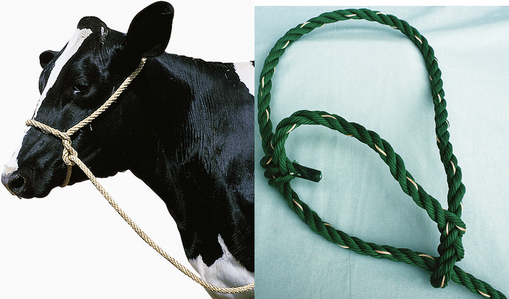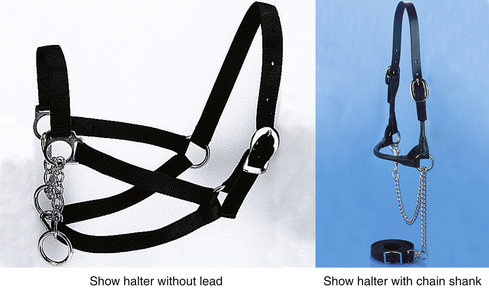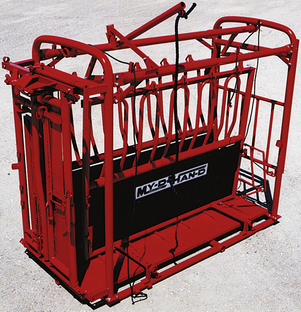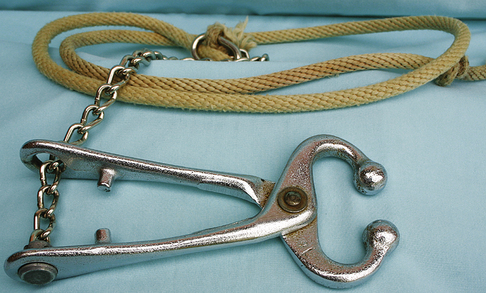CHAPTER 5 Instruments Used for Bovines
This group of instruments is used to restrain, treat, and care for cattle.
INSTRUMENT
Rope Halter
| FUNCTION | To control an animal’s head while the animal is in a chute or while it is being led. |
| CHARACTERISTICS | This is an adjustable halter. The headstall can be lengthened and the noseband made wider by pulling the lead rope through a series of loops. The noseband is tightened by pulling on the lead rope. This is an important distinction because if the noseband is placed around the animal’s neck, it can become a choking hazard; in addition, it does not provide good control of the head. When the halter is placed on the head properly, the end of the lead rope should be on the left side of the animal’s cheek. These halters are made of round plastic, polyethylene, nylon, or sisal ropes. They come in sizes that fit adults and calves and are used for routine work, such as jugular venipuncture, drenching, surgical procedures on the head, and teaching a show animal how to walk on lead. |
INSTRUMENT
Fabric Show Halter
| FUNCTION | To lead cattle in a show. |
| CHARACTERISTICS | The headstall and noseband are held in place by a chain shank that is slipped under the chin and attached to the bottom of the noseband. The chain shank allows better control of an animal than does a nylon strap. This kind of halter is used only after an animal has been taught to be led using a rope halter. |
INSTRUMENT
Whips
| FUNCTION | To make livestock move and to make the handler look bigger. |
| CHARACTERISTICS | A fiberglass shaft ends in a nylon popper that can be flicked at an animal that is balking or refusing to move. The ideal areas to aim for are the heels or across the buttocks; that makes the animal move forward. The whip can also be extended out to the side of the handler to make it look as though the handler has long arms, which is useful in getting an animal to take a turn. Whips have poppers of varying lengths: a driving whip has approximately a 7-inch popper; a lunge whip, which is used with horses, has a 6-foot popper; and a classic stock whip has a popper that is between 8 and 18 inches long. Some stockmen tie a small leather strap to the popper for an additional popping sound. |
INSTRUMENT
Cattle Prods
| FUNCTION | To make livestock move into chutes or alleyways. |
| COMMON NAME | Hot Shot™ |
| CHARACTERISTICS | These prods are battery powered so they can deliver an electric jolt to an animal. Proper placement is important. To move an animal forward rather than down, the electrodes should be placed under the tail or anywhere on the vertical surface of the rump. An animal can be turned if the prod is used on the side of the body or the neck. If the electrodes are placed on the body’s top, the animal becomes confused because the only way for it to move is down. This is a fairly rough form of motivation and should be used judiciously. |
INSTRUMENT
Squeeze Chute
| FUNCTION | To secure a cow or bull in place while maintaining access to its head, feet, and rear. |
| COMMON NAME | Chute |
| CHARACTERISTICS | Most chutes work on the principle of catching the head with some type of squeeze mechanism. Lateral movement is prevented by squeezing the walls of the chute together. Access to the rear is facilitated by a gate or bar that is placed across the back legs of the animal. Feet can be examined by lowering the side panels. This is an extremely useful instrument for cattle restraint, especially for beef cattle. |
< div class='tao-gold-member'>
Only gold members can continue reading. Log In or Register to continue
Stay updated, free articles. Join our Telegram channel

Full access? Get Clinical Tree








